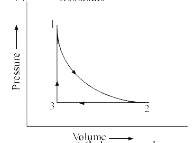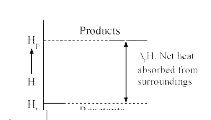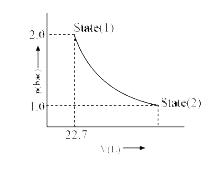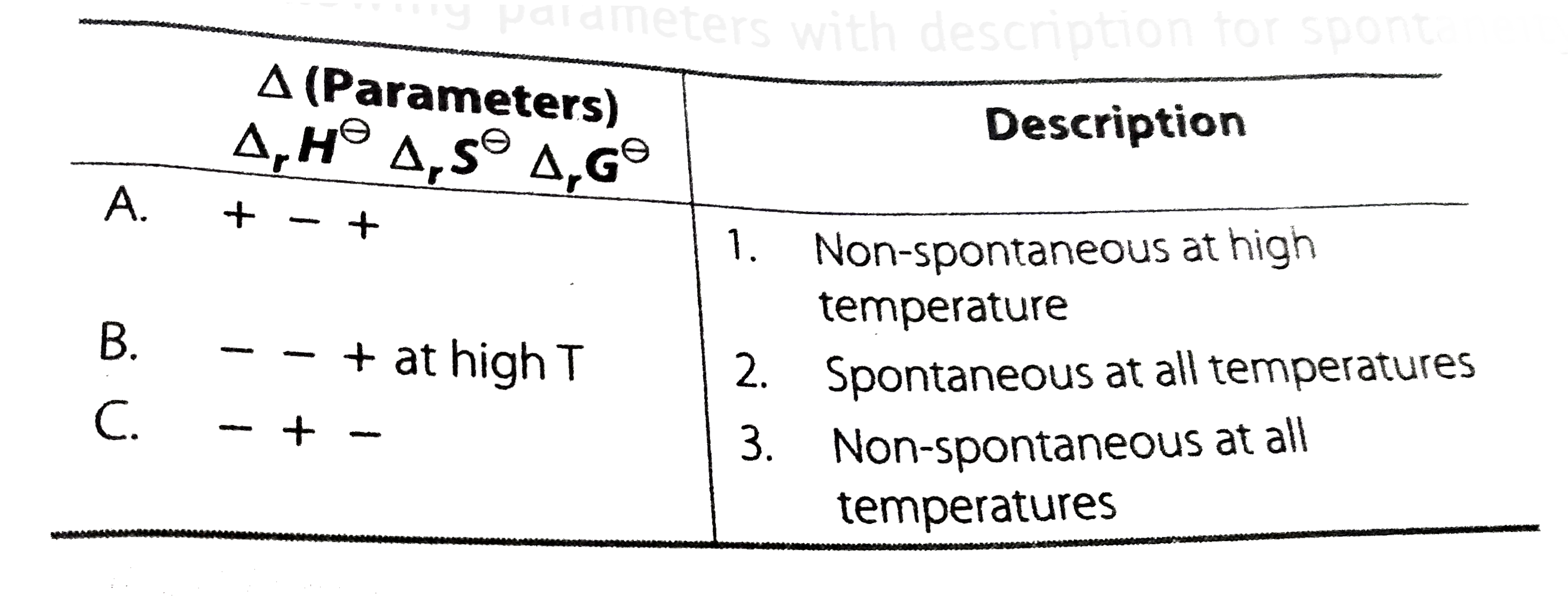Complete Solutions to Multiple choice questions of chapter THERMODYNAMICS of Class 11 book with complete answers and questions
| Class 11 | CHEMISTRY |
| Chapter | THERMODYNAMICS |
| NCERT EXEMPLAR | Multiple choice questions |
| Number Of Questions | 62 |
| Academic Year | 2023-24 |
Thermodynamics is not concerned about….
View SolutionWhich of the following statement is correct ?
View SolutionThe state of gas can be described by quoting the relationship between
View SolutionThe volume of gas is reduced to half from its original volume. The specific heat will be
View SolutionDuring complete combustion of one mole of butane ,2658Kj of heat is released. The thermochemical reaction for above change is
View Solution`delta_(f) U^(Ó¨) "of formation of" CH_(4)(g)` at a certain temperature is `-393Jmol^(-1).` The value of `delta H^(Ó¨)is:`
View SolutionIn an adibatic process, no transfer of heat takes place between system and surroundings. Choose the correct option for free expansion of an ideal gas under adiabatic conditions from the following :
View SolutionThe pressure volume work for an ideal gas can be calculated by using the expression `w=-int_(V_(i))^(v_(f))Pex dV`. The work can also be calculated from the pV-plot by using the area under the curve within the specified limits. When an ideal gas is compressed (a) reversibly or (B) irreversibly from volume `V_(i)` to `V_(f)` choose the correct option.
View SolutionThe entropy change can be calculated by using the expression `DeltaS-(q_(rev))/(T)`. When water freezes in a glass beaker, choose the correct statement amongst the following:
View SolutionOn the basic of thermochemical equations (I),(II)and (III), Find out which of the algebraic relationships given in options (a)to (d) is correct ?
(I)`C("graphite")+O_(2)(g)to CO_(2)(g),`
`Delta_(r)H=XKJmol^(-1)`
(II)`C("graphite")+(1)/(2)O_(2)(g)toCO(g),`
`Delta_(r)H=yKJ mol^(-1)`
`(III) CO(g)+(1)/(2)O_(2)(g)toCO_(2)(g), Delta_(r)H=zKJ mol^(-1)`
View SolutionConsider the reactions given below .On the basis of these reactions ,Find out which of the algebraic relations given in options (a) to(d) is correct?
`(p)C(g)+4H(g)toCH_(4)(g), Delta_(r)H=xKJ mol^(-1)`
`(Q)C("graphite")+2H_(2)(g)to CH_(4)(g),`
`Delta_(r)H=yKJmol^(-1)`
View SolutionThe enthalpy of elements in their standard atates are taken as zero .The enthalpy of formation of a compound:
View SolutionEnthalpy of sublimation of a substance is equal to :
View SolutionWhich of the following is not correct ?
View SolutionThermodynamics mainly deals with:
View SolutionIn an exothermic reaction heat is evolved and system loses heat to the surrounding. For such system
View SolutionThe spontaneity means having the potential to proceed without assistance of external agency. The processes which occur spontaneously are
View SolutionFor an ideal gas, the work of reversible expansion under isothermal condition can be calculated by using expression ` = -nRT ln.(V_(f))/(V_(i))`. A sample containing 1.0 mol of an ideal gas is expanded isothermally and reversible to ten times of its original volume, in two separate experiments. The expansion is carried out at 300 K and at 600 K respectively. Choose the correct option
View SolutionConsider the following reaction between zinc and oxygen and choose the correct options out of the options given below
`2Zn(s)+ O_(2)(g) to 2 ZnO_(s): DeltaH=-693.8 kJ mol^(-1)`
View Solution18.0 g of water completely vaporises at `100^(@)C` and 1 bar pressure and the enthalpy change in the process is `40.79 kJ mol^(-1)`. What will be the enthalpy change for vaporising two moles of water under the same conditions ? What is the standard enthalpy of vaporisation for water ?
View SolutionOne mole of acetone requires less heat to vaporise than 1 mole of water. Which of the two liquids has higher enthalpy of vaporisation ?
View SolutionStandard molar enthalpy of formation, `Delta_(f) H^(Θ)` is just a special case of enthalpy of reaction, `Delta_(r) H^(Θ)`. Is the `Delta_(r) H^(Θ)`? Given reason for your answer.
`CaO (s) + CO_(2) (g) rarr CaCO_(3) (s) , Delta_(f) H^(Θ) = - 178.3 kJ mol^(-1)`
View SolutionThe value of `Delta_(f) H^(Θ)` for `NH_(3)` is `-91.8 kJ mol^(-1)`. Calculate enthalpy change for the following reaction.
`2NH_(3) (g) rarr N_(2) (g) + 3H_(2) (g)`
View SolutionEnthalpy is an extensive property. In general, if enthalpy of an overall reaction `A rarr B` along one route is `Delta_(r) H " and Delta_(r) H_(1), Delta_(r) H_(2), Delta_(r) H_(3)`..... Represent enthalpies of intermediate reactions leading to product B. What will be the relation between `Delta_(r)H` overall reaction and `Delta_(r)H_(1), Delta_(r)H_(2)`... etc for intermediate reaction.
View SolutionThe enthaply of atomisation for the reaction : `CH_(4)(g) to C(g) + 4 H(g)` is `1665 kJ "mol"^(-1)`.What is the bond enthalpy of C-H bond? (Keep your answer in KJ/mol and three digits only)
View SolutionUse the following data to calculate `Delta_("lattice") H^(@)` for NaBr. `Delta_("sub")H^(@)` for sodium metal `=108.4 kJ mol^(-1)`, ionization enthalpy of sodium `=496 kJ mol^(-1)`., electron gain enthalpy of bromine `=-325 kJ mol^(-1)` bond dissociation enthalpy of bromine `=192 kJ mol^(-1) , Delta _f H^(@)` for `NaBr(s) - 360 kJ mol^(-1)`.
View SolutionGiven that `DeltaH` = 0 for mixing of two gases.Explain whether the diffusion of these gases into each other in a closed container is a spontaneous process or not?
View SolutionHeat has randomising influence on a system and temperature is the measure of average chaotic motion of particles in the system.Write the mathematical relation which relates these three parameters.
View SolutionIncrease in enthalpy of the surroundings is equal to decrease in enthalpy of the system.Will the temperature of system and surroundings be the same when they are in thermal equilibrium?
View SolutionAt 298 K, `K_(p)` for the reaction : `N_(2)O_(4)(g) iff 2NO_(2)(g)` is 0.98. Predict whether the reaction is spontaneous or not.
View Solution(a) A sample of 1.0 mol of a monoatomic ideal gas is taken through a cyclic process of expansion and compression as shown in figure. What will be the value of `DeltaH` for the cycle as a whole?
(b) Which quantity out of `Delta_(r)G` and `Delta_(r)G^(Theta)` will be zero at equilibrium?

View SolutionThe standard molar entropy of `H_(2)O(l)` is `70 J K^(-1) "mol"^(-1)`.Will the standard molar entropy of `H_(2)O(s)` be more or less than `70 J K^(-1) "mol"^(-1)`?
View SolutionIdentify the state functions and path functions out of the following:
enthalpy, entropy, heat, temperature, work, free energy.
View SolutionThe molar enthalpy of vapourisation of acetone is less than that of water.Why?
View SolutionWhich quantity out of `Delta_(r)G` or `Delta_(r)G^(@)` will be zero at equilibrium?
View SolutionPredict the change in internal energy for an isolated system at constant volume.
View SolutionAlthough heat is a path function but heat absorbed by the system under certain specific conditions is independent of path. What are those conditions? Explain.
View SolutionExpansion of a gas in vaccum is called free expansion.Calculate the work done and the change in internal energy when 1 litre of ideal gas expands isothermally into vaccum until its total volume is 5 litre?
View SolutionHeat capacity `(C_(p))` is an extensive property but specific heat (C) is an intensive property.What will be the relation between `C_(p)` and C for 1 mol of water? (Keep your answer in J/K and in two digits only)
View SolutionThe difference between `C_(p)` and `C_(v)` can be derived using the empirical relation H = U + pV. Calculate the difference between `C_(p)` and `C_(v)` for 10 moles of an ideal gas.
View SolutionIf the combustion of 1 g of graphite produces -20.7 kJ of heat, what will be molar enthalpy change? Give the significance of sign also.
View SolutionThe net enthalpy change of a reaction is the amount of energy required to break all the bonds in reactant molecules minus amount of energy required to form all the bonds in the product molecules.What will be the enthalpy change for the following reaction.
`H_(2)(g) + Br_(2)(g) to 2HBr(g)`
Given that bond energy of `H_(2), Br_(2)` and HBr is 435 kJ `mol^(-1)`, 192 kJ `mol^(-1)` and `368 kJ mol^(-1)` respectively. (Keep your answer in magnitude and in KJ/mol)
View SolutionThe enthalpy of vaporisation of ` C CI_(4)` is `30.5 kJ "mol"^(-1)`.Calculate the heat required for the vapourisation of 284 g of `C CI_(4)` at constant pressure. (Molar mass of ` C CI_(4) = 154u`). (Keep your answer in KJ and two digits only)
View SolutionThe enthalpy of reaction for thr equation
`2H_2(g) +O_2(g) rarr 2H_2O(l)` is `DeltaH^@=-572kj/mol`
what will be the standard enthalpy for the formation of `H_2O`(l)?
View SolutionWhat will be the work done on an ideal gas enclosed in a cylinder, when it is compressed by a constant external pressure `p_(ext)` , in a single step as shown in figure? Explain graphically.

View SolutionHow will you calculate work done on an ideal gas in a compression, when change in pressure is carried out in infinite steps?
View SolutionRepresent the potential energy/enthalpy change in the following process graphically
(a) Throwing a stone from the ground to roof.
(b) `1/2H_(2)(g) + 1/2Cl_(2)(g)` `HCl(g) Delta_(r)H^(@) = -93.2 kJ mol^(-1)`
In which of the process potential energy/enthalpy change in contributing factor to the spontaneity?
View SolutionEnthalpy diagram for a particular reaction is given in figure. Is it possible to decide spontaneity of a reaction from given diagram. Explain

View Solution1.0 mol of a monoatomic ideal gas is expanded from state (1) to state (2) as shown in figure. Calculate the work done for the expansion of gas from state (1) to state (2) as 298 K.

View SolutionAn ideal gas is allowed to expand against a constant pressure of 2 bar from 10 L to 50 L in one step. The amount of work done by the gas is x. if the same expansion were carried out reversible, what is the relation of work done with the earlier case?
View SolutionMatch the following

View SolutionMatch the following processes with entropy change

View SolutionMatch the following parameters with description for spontaneity

View SolutionMatch the following

View SolutionAssertion (A). Combustion of all organic compounds is an exothermic reaction.
Reason (R). The enthalpies of all elements in their standard state are zero
View SolutionAssertion (A). Spontaneous process is an irreversible process and may be reversed by some external agency.
Reason (R). Decrease in enthalpy is a contributory factor for spontaneity
View SolutionAssertion (A). A liquid crystallises into a solid and is accompanied by decrease in entropy.
Reason (R). In crystals, molecules organise in an ordered manner.
View SolutionDerive the relationship between `Delta H " and " Delta U` for an ideal gas. Explain each term involved in the equation.
View SolutionExtensive properties depends on the quantity of matter but intensive properties do not. Explain whether the following properties are extensive or intensive.
Mass internal energy, pressure, heat capacity, molar heat capacity, density, mole fraction, specific heat, temperature and molarity
View SolutionThe lattice enthalpy of an ionic compound is the enthalpy when one mole of an ionic compoud present in its gaseous state, dissociates into its ions. It is impossible to determine it directly by experiment. Suggest and explain in indirect method to measure lattice enthalpy of NaCl(s).
View Solution`Delta G` is energy availabe to do useful work and is thus a meaure of "Free energy". Show mathemactically that `Delta G` is a measure of free energy. Find the unit of `Delta G`. IF a reaction has positive enthalpy change and positive entropy change, under what condition will the reaction be spontaneous ?
View SolutionGraphically shoe the total work done in an expansion when the state of an ideal gas is changed reversibly and isothermally from `(p_(i), V_(i))` to `(p_(f), V_(f))`. With the help of a pV plot compare the work done in the above case with that carried out against a constant pressure `p_(f)`.
View Solution
Multiple choice questions questions and complete solutions for chapter THERMODYNAMICS of NCERT CHEMISTRY (HINGLISH) of Class 11